350 Search Results for aided language input
October 12, 2018
by Carole Zangari -
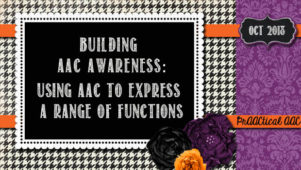
Most times, the goal of AAC intervention is to help those with complex communication needs be able to express whatever they want at any time. For some individuals, we over-emphasize the tools and strategies they will need to get the things they want, whether it is social engagement (attention), assistance (help), objects, events, or even being able to protest or reject unwanted situations. Michigan-based SLP Rachael Langley works tirelessly to support technologies and services that give access to the full range to communicative functions. When she offered to share her thoughts on this topic with us, we jumped on the chance. Enjoy! :::::::::::::::::::::::::::::::::::::::::::::::::::::::::::::::::::::::::::::::::::::::::::::::::::::::::::::::::::::::::::::::::::::::::::::::::: Four Functions of Language There are many ways to emphasize AAC use and embed aided language into the day. Sometimes we use a core vocabulary approach to teach specific vocabulary. But we can also approach AAC learning by focusing on a specific function or pragmatic use of language.... [Read More...]
October 11, 2018
by Carole Zangari -
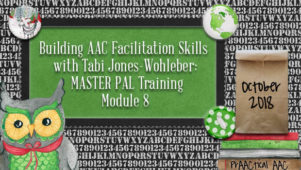
Our AAC Training Series continues today and we remain extremely appreciative that West Virginia based SLP Tabi Jones-Wohleber allows us to share these presentation materials. Today’s training materials center on a topic that will help AAC interventionists strengthen their relationships with AAC learners and provide important language learning opportunities at the same time. This module, Response NOT Required, is all about interactions that engage our learners and invite them into the conversation. The instructional time for Module 8 is about 20 minutes so this can feasibly be shared in a formal or informal sharing session before or after the school day. ::::::::::::::::::::::::::::::::::::::::::::::::::::::::::::::::::::::::::::::::::::::::::::::::::::::::::::: Model as a MASTER PAL Module 8: Response NOT Required Facilitator Guidelines When I talk about modeling without expectation of a response, I often get quizzical sideways glances. It is not an intuitive way of interacting, especially in an educational environment where responding is inherent in classroom... [Read More...]
June 28, 2018
by Carole Zangari -
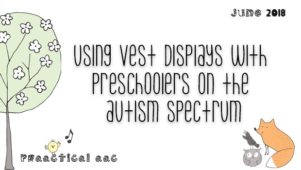
We’re so pleased to welcome back Dr. Carol Goossens’, an AAC pioneer who is an internationally-recognized consultant, SLP, and Special Educator from New York. Throughout her career, she has consulted extensively in a variety of classrooms serving the full spectrum of children with special needs. Dr. Goossens’ has presented both nationally and internationally about her collaborative work with teachers, therapists, and families. In today’s post, she shares a treasure trove of ideas on using wearable AAC. Learn more about her approach to using vest displays in this extensive post. :::::::::::::::::::::::::::::::::::::::::::::::::::::::::::::::::: Using Vest Displays with Preschoolers on the Autism Spectrum When working with students on the spectrum, we often struggle to gain and maintain their attention, especially during group activities such as Circle Time/Morning Meeting. The songs offered during Circle Time, however, create a great forum for working on a variety of communication skills, e.g., claiming a turn, announcing a song, choosing... [Read More...]
September 22, 2016
by Carole Zangari -
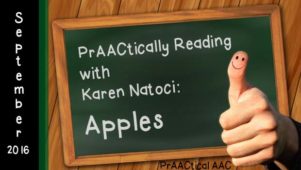
We are so happy to welcome back SLP Karen Natoci who graciously agreed to continue writing about how she uses interactive book reading to build language skills with beginning communicators. You can see her earlier posts in the PrAACtically Reading series here. In this post, she shares activity ideas for two books on apples. You can learn more about Karen and download her materials toward the bottom of the post. Enjoy! ::::::::::::::::::::::::::::::::::::::::::::::::::::::::: Books: Apples by Ken Robbins and Apples for Everyone by Jill Esbaum Adapted and simplified Powerpoint Book Apples by Karen Natoci Core Vocabulary focus: here, in, where Additional Vocabulary focus: Body parts; red, round, yellow, green, COMMUNICATION Matrix (Rowland, 2009) Level: I-VII (all levels!) ————————————————————————————————————————————- It is September and apple time! I chose to feature these books from which to adapt material suitable for students with complex communication needs. I have a simplified power point... [Read More...]
April 18, 2016
by Carole Zangari -
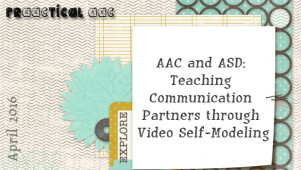
It is an honor to have Dr. Joanne Cafiero, an AAC consultant for individuals with complex communication needs and Autism Spectrum Disorders, as a guest contributor for today’s post. Dr. Cafiero is the author of Meaningful Exchanges for People with Autism an Introduction to AAC (2005). She is a consulting editor for Focus on Autism and Other Developmental Disabilities and has guest edited several of ASHA’s Perspectives in AAC. She was a member of the National Academy of Sciences Committee on Educational Interventions for Children with Autism (2001) and is currently working on an update on AAC and Autism for the Academy. In this post, she shares some of her work on video self-modeling. ::::::::::::::::::::::::::::::::::::::::::::::::: Growing research and first-person reports are illuminating the unique sensory and motor differences experienced by people on the Autism Spectrum. This new information has a huge impact on the AAC practitioner. Motor planning differences in ASD can... [Read More...]
March 23, 2016
by Carole Zangari -

Looking for a research-supported strategy to accelerate communication learning? Consider adding video models to your AAC intervention plan. In previous posts, we’ve written about our love for this strategy and shared resources . Today, we visit one our our favorite preschool teachers, Lindy McDaniel of The Considerate Classroom, to look at an example of how she uses this strategy to support young learners.
October 19, 2015
by Carole Zangari -
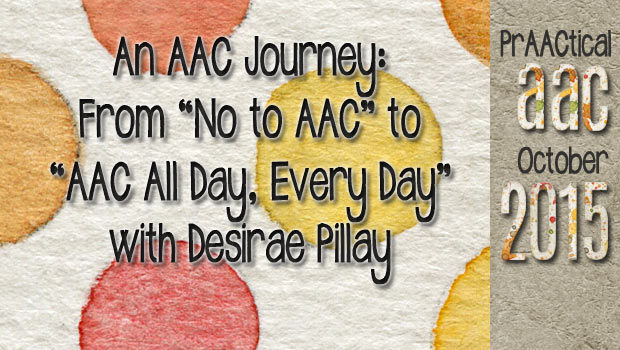
What better way to celebrate AAC Awareness Month than to share AAC stories from around the world? In this post, we welcome Desirae Pillay, who shares a bit about her daughter, Savannah, and their AAC journey. As the mother of a young adult with ASD and cerebral palsy, Desirae has taken what she has learned about AAC and is using it to help others outside of her family. Desirae began her journey with AAC in 2003 when she could not find a qualified AAC specialist to assist her with her daughter. Her experience and informal learning gained her a job for an AT company. When her daughter’s health needs became pressing, she resigned her job and worked part time as a Disability Consultant for various organisations. Desirae recently returned to work as an AT Advisor, where she trains on a range of topics about communication for people with disabilities. Her passion is for... [Read More...]
August 10, 2015
by Carole Zangari -
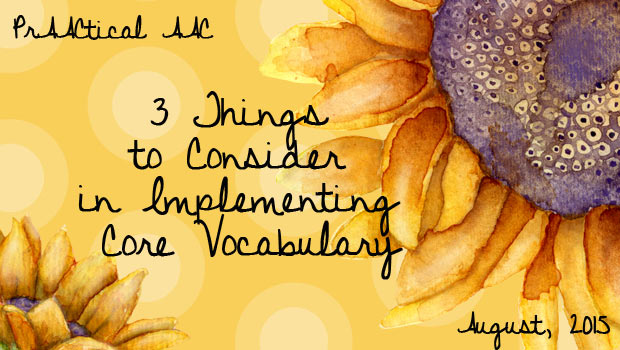
The power of core vocabulary is only realized when AAC is being utilized throughout the day. A key benefit of having core words on an AAC system is that they apply to any situation, in any location, with any communication partners. But unless we’re actually teaching and using the AAC under those conditions, we haven’t really tapped into the power that they offer. It would be like upgrading to a powerful ‘gamer’ laptop, then just using it to check email. Core vocabulary is a powerful concept, but it only becomes a powerful tool when it gets used throughout the day by anyone who speaks to the learner. It may take some time to get there, but it’s critical that we keep striving for this. Otherwise, we’re checking email on a super-charged computer. While powerful, core words can’t do everything. AAC learners also need words that reflect their own lives and... [Read More...]
August 4, 2015
by Carole Zangari -
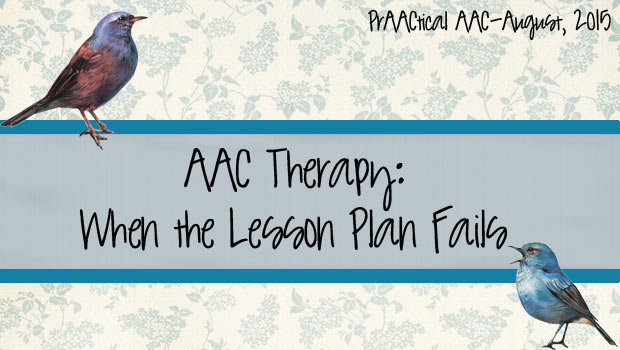
We’ve all been there. You have meaningful goals, engaging materials, and a solid lesson plan for our therapy session. Five minutes into the session, it’s clear that the AAC learner has little or no interest in what we’ve prepared. Now what? Our choices are limited: persevere with the plan, modify it somewhat, or scrap it entirely. What’s a clinician to do? Take A Breath The first thing to do is breathe. Know that you are not the first one to struggle to engage this learner, and you won’t be the last. Think of it not as an excuse for an unproductive session but as a problem-solving challenge. Previous clinicians may have justified the session’s difficulties and atttibuted them to the learner’s lack of engagement, limited attention span, or behavioral problems. Personally, I feel sad for those clinicians because when we take that approach, not only do we fail the client,... [Read More...]
December 19, 2014
by Carole Zangari -

Whether it is electronically or by postal mail, many of our prAACtical friends are sending and receiving holiday greetings this week. Here are some thoughts on taking advantage of their novelty and using them to build language and literacy skills. Core Vocabulary: Lots of opportunity to practice using core words. Can I have it? I like it. It is fun. Give it to me. Do you want it? I want to see. We can do it (together). I can see it. Do you want to do more? Can you see the ___? WH Questions: Make it a game to pick a card to talk about. Everyone can have a turn asking and answering questions like these and get some core word practice in at the same time. Who gave it? Where are they? What do you think? Why do you like (not like) it? Stop and Go: Have a cute... [Read More...]









